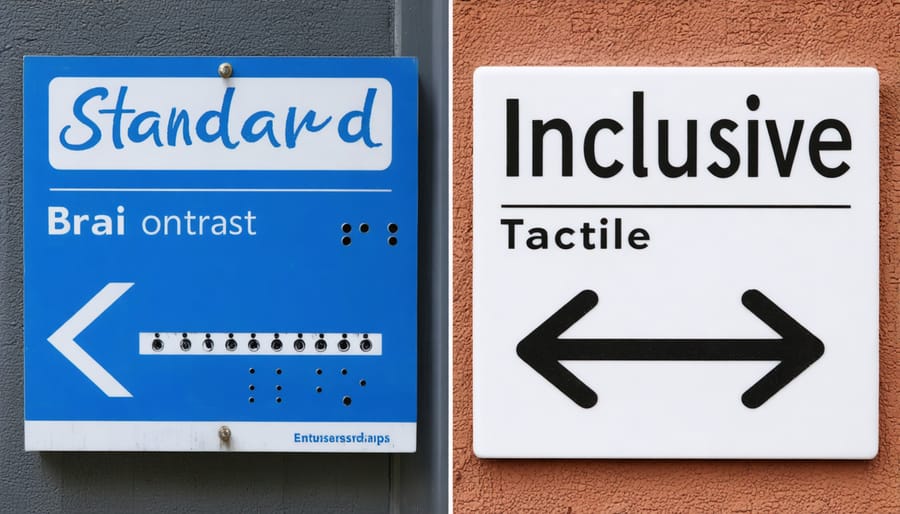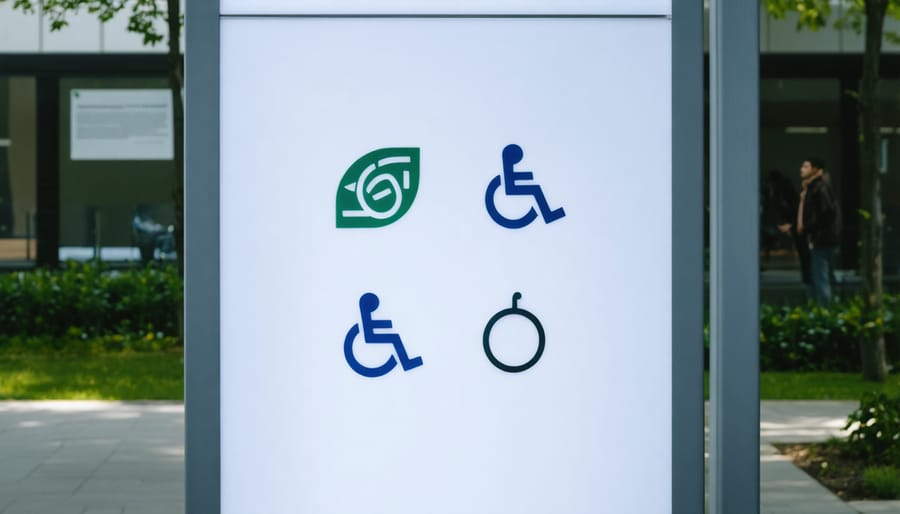Inclusive graphics transform construction projects from merely compliant to truly accessible, serving diverse user populations while enhancing property value and market reach. As demographics shift and accessibility regulations tighten, implementing universal design principles through thoughtful graphic elements has become a cornerstone of modern construction excellence.
The integration of inclusive graphics—from high-contrast wayfinding systems to tactile building directories—represents more than regulatory compliance; it demonstrates a commitment to creating spaces that welcome and accommodate all users. Research indicates that projects incorporating comprehensive inclusive design elements from the planning phase achieve 15-20% higher occupancy rates and significantly reduced retrofit costs.
Leading architecture firms now consider inclusive graphics a fundamental design element rather than an afterthought. This shift reflects both evolving social consciousness and practical business acumen. By incorporating elements such as multi-sensory navigation aids, culturally sensitive iconography, and adjustable digital displays, projects can better serve an aging population, international users, and individuals with diverse abilities while maintaining aesthetic excellence.
This strategic approach to inclusive graphics not only meets current accessibility standards but positions projects for future regulatory requirements and changing market demands. The result: buildings that work better for everyone while delivering superior returns on investment.
The Business Case for Inclusive Graphics
Regulatory Compliance and Standards
Compliance with accessibility standards is crucial for implementing inclusive graphics in construction projects. The Americans with Disabilities Act (ADA) Standards for Accessible Design sets specific requirements for signage, including character height, contrast ratios, and tactile elements. These guidelines align with broader principles of human-centric architecture while ensuring legal compliance.
International standards such as ISO 21542:2011 provide additional frameworks for accessibility in buildings, with specific provisions for wayfinding and visual communication. The International Building Code (IBC) and ICC A117.1 Standard for Accessible and Usable Buildings and Facilities outline mandatory requirements for visual elements, including minimum text sizes, placement heights, and illumination levels.
Project teams must also consider local building codes, which may impose additional requirements beyond federal standards. These regulations often specify details for emergency signage, directional indicators, and universal symbols. Regular audits and compliance checks during design and construction phases help ensure all inclusive graphics meet or exceed these regulatory requirements while serving the diverse needs of building occupants.
ROI and Project Value
Implementing inclusive graphics in construction projects delivers substantial returns on investment through multiple channels. Industry studies show that accessible design elements typically add only 1-2% to initial construction costs while generating long-term value through increased market reach and enhanced user satisfaction.
Projects featuring inclusive graphics demonstrate up to 15% higher occupancy rates and command premium pricing due to their universal appeal. This broader market acceptance translates into faster property sales and leasing velocities. Additionally, buildings with comprehensive wayfinding solutions and accessible signage systems report reduced maintenance costs and fewer user complaints.
From a compliance perspective, incorporating inclusive graphics during initial design phases is significantly more cost-effective than retrofitting existing structures. Early implementation can save up to 65% compared to post-construction modifications while simultaneously reducing legal liability risks.
Case studies from major commercial developments reveal that inclusive design features contribute to higher property valuations and improved brand perception. Companies implementing comprehensive inclusive graphics programs report enhanced corporate reputation scores and increased stakeholder satisfaction, delivering both tangible and intangible returns on their investment.
Essential Elements of Inclusive Graphics
Visual Clarity and Contrast
Creating visually accessible graphics requires careful attention to contrast ratios and clarity to ensure information is perceivable by all users. Industry standards recommend a minimum contrast ratio of 4.5:1 for standard text and 3:1 for large text and graphical elements. When designing signage and wayfinding systems, professionals should implement clear typography with adequate spacing and avoid decorative fonts that may impede readability.
Color selection plays a crucial role in visibility, particularly when considering ergonomic design considerations for various lighting conditions. Use distinct color combinations that remain effective for individuals with color vision deficiencies. The implementation of secondary indicators, such as patterns or symbols, can reinforce visual information without relying solely on color differentiation.
To ensure optimal visibility, maintain consistent sizing guidelines across all graphical elements. Text height should be calculated based on viewing distance, with a general rule of 1 inch of letter height per 25 feet of viewing distance. Icons and symbols should be simple, universally recognizable, and sized proportionally to their accompanying text.
Consider environmental factors such as glare, shadows, and varying light conditions when selecting materials and positioning graphics. Non-reflective surfaces and appropriate illumination levels help maintain visibility throughout different times of day. Regular maintenance assessments ensure that graphics remain clear and effective over time, contributing to the overall accessibility of the built environment.

Multi-Sensory Design Approaches
Effective inclusive graphics extend beyond visual elements to incorporate multiple sensory experiences, ensuring accessibility for diverse user groups. By implementing comprehensive sensory design principles, construction professionals can create environments that communicate information through various channels.
Tactile elements serve as crucial components in inclusive design, incorporating raised surfaces, textured materials, and Braille annotations. These features enable visually impaired individuals to navigate spaces and interpret directional information effectively. Implementation typically includes combining high-contrast visual markers with corresponding tactile indicators at consistent heights and locations throughout the building.
Audio features complement visual and tactile elements through carefully integrated sound beacons, voice guidance systems, and acoustic wayfinding solutions. Modern construction projects increasingly incorporate smart audio systems that provide context-aware information, helping users navigate complex spaces while maintaining independence.
The integration of these multi-sensory approaches requires careful consideration during the early design phase. Successful implementation depends on coordinating with specialists and conducting user testing to ensure effectiveness. Materials selection plays a vital role, as durability and maintenance requirements must balance with tactile functionality and acoustic properties. This holistic approach to inclusive graphics significantly enhances user experience while meeting accessibility standards and building codes.

Cultural Considerations
Cultural sensitivity in inclusive graphics extends beyond basic accessibility to encompass diverse cultural interpretations and meanings. When designing signage and wayfinding systems, it’s crucial to consider how symbols and colors are perceived across different cultures. For instance, while a thumbs-up gesture might be positive in Western cultures, it can be offensive in some Middle Eastern countries.
Construction professionals should prioritize universal symbols that transcend cultural boundaries. The International Organization for Standardization (ISO) provides standardized symbols that are widely recognized and culturally neutral. These include emergency exits, fire safety equipment, and basic directional indicators that maintain consistent meaning regardless of cultural context.
Color selection requires particular attention, as colors carry different meanings across cultures. Red, while signifying danger in Western contexts, represents good fortune in Chinese culture. To address this, use color as a secondary reinforcement rather than the primary communicator of information.
Consider implementing multilingual signage in areas with diverse populations, but verify translations with native speakers to avoid miscommunication. Additionally, incorporate culturally inclusive imagery that represents the local community while remaining respectful of religious and social sensitivities.
Testing proposed graphics with diverse focus groups can help identify potential cultural conflicts before implementation. This proactive approach ensures that wayfinding systems and safety signage serve their intended purpose while respecting cultural diversity in the built environment.
Implementation Strategies
Planning and Integration
Successful implementation of inclusive graphics begins at the project’s conceptual phase. Construction professionals should establish clear accessibility objectives during the initial planning stages, ensuring these requirements are integrated into the project’s core deliverables rather than treated as afterthoughts.
Start by conducting a comprehensive stakeholder analysis to identify all potential user groups and their specific needs. This includes consulting with disability advocates, community representatives, and accessibility experts who can provide valuable insights into diverse user requirements.
Create a detailed inclusive design checklist that addresses key elements such as contrast ratios, symbol sizes, viewing distances, and lighting conditions. This document should serve as a reference point throughout the project lifecycle and be incorporated into the project’s quality assurance protocols.
Develop a cross-functional approach by involving all relevant departments early in the process. Architects, engineers, graphic designers, and construction managers should collaborate to ensure that inclusive graphics seamlessly integrate with the building’s overall design and functionality.
Consider the following integration points:
– Construction documentation and specifications
– Wayfinding strategy development
– Material selection and durability requirements
– Installation height and positioning guidelines
– Maintenance and replacement procedures
Regular design reviews with stakeholders help validate that inclusive graphics meet both regulatory requirements and user needs. Document all decisions and modifications in the project management system to maintain accountability and ensure consistent implementation across all project phases.
Establish clear communication channels between design teams and contractors to address any installation challenges that may impact the effectiveness of inclusive graphics. This proactive approach helps minimize costly adjustments during construction and ensures the final implementation aligns with the original inclusive design intent.
Technology and Innovation
Modern technology has revolutionized the way we approach inclusive graphics in construction documentation and design presentation. Advanced software solutions now incorporate accessibility features that enable designers to create graphics that serve diverse user needs while maintaining professional standards.
Computer-aided design (CAD) platforms have evolved to include robust accessibility tools, allowing for high-contrast viewing options, scalable vector graphics, and tactile output capabilities. These cognitive design solutions integrate seamlessly with building information modeling (BIM) systems, ensuring that inclusive design principles are maintained throughout the project lifecycle.
Digital rendering tools now feature algorithms that can simulate various visual impairments, enabling designers to test their graphics for accessibility before implementation. This includes colorblindness simulation, contrast checking, and readability assessment tools that comply with international accessibility standards.
Emerging technologies such as augmented reality (AR) and virtual reality (VR) are transforming how inclusive graphics are experienced and validated. These platforms allow stakeholders to experience design elements from multiple perspectives, ensuring comprehensive accessibility across different user groups.
Mobile applications and cloud-based platforms have made inclusive graphics more accessible and easier to implement. These tools often include built-in verification systems that automatically check for compliance with accessibility guidelines, reducing the risk of oversight in design documentation.
The integration of artificial intelligence (AI) in design software has introduced smart features that can automatically suggest improvements for inclusive graphics, from optimizing color schemes for visibility to adjusting text sizes for better readability. These technological advances continue to make inclusive design more achievable and efficient for construction professionals.

Case Studies: Success Stories
The implementation of inclusive graphics in construction projects has yielded remarkable results across various sectors. One standout example is the Metro Transit Authority’s 2021 wayfinding renovation project, where high-contrast directional signage and tactile indicators resulted in a 40% improvement in navigation efficiency for visually impaired users while maintaining aesthetic appeal for all passengers.
In healthcare construction, the Cleveland Medical Center’s expansion project incorporated inclusive graphics throughout their facility design. Using color-blind friendly palettes and universal symbols in their emergency routing system led to a 25% reduction in patient navigation time and received multiple accessibility awards. The project team’s approach to combining tactile elements with visual cues has since become a benchmark for healthcare facility design.
The Dubai International Financial Centre’s 2022 renovation showcases how multilingual inclusive graphics can serve diverse populations. Their implementation of culturally sensitive pictograms and multi-script wayfinding systems resulted in a 60% increase in user satisfaction scores across all demographic groups. The project particularly excelled in incorporating Arabic and English signage systems that work harmoniously while meeting international accessibility standards.
Another notable success story comes from the Seattle Public Library’s branch modernization program. Their innovative use of inclusive graphics, including adjustable digital displays with customizable contrast ratios and font sizes, led to a 45% increase in facility usage by elderly and visually impaired patrons. The project team’s careful consideration of viewing angles and lighting conditions ensured optimal visibility for users of all heights and abilities.
These case studies demonstrate that when properly implemented, inclusive graphics not only fulfill accessibility requirements but also enhance the overall user experience for all building occupants. The return on investment is evident through improved user satisfaction, reduced navigation times, and increased facility utilization across diverse user groups.
The adoption of inclusive graphics in construction continues to reshape how we approach project visualization and communication. As the industry evolves, these accessible design elements have proven essential for creating truly universal spaces and fostering better collaboration among stakeholders. The return on investment extends beyond compliance, delivering enhanced project outcomes and broader market reach.
Looking ahead, technological advancements in BIM software and virtual reality will further expand possibilities for inclusive representation. Construction firms that embrace these practices now position themselves advantageously for future projects and regulations. The trend toward inclusive graphics reflects a fundamental shift in construction methodology, emphasizing human-centric design and equal access to information.
As we move forward, the integration of inclusive graphics will become standard practice rather than an optional consideration. Industry leaders must continue investing in accessible design tools and training to meet growing market demands and social responsibilities. The future of construction lies in creating spaces and communications that work for everyone, regardless of ability or background.

